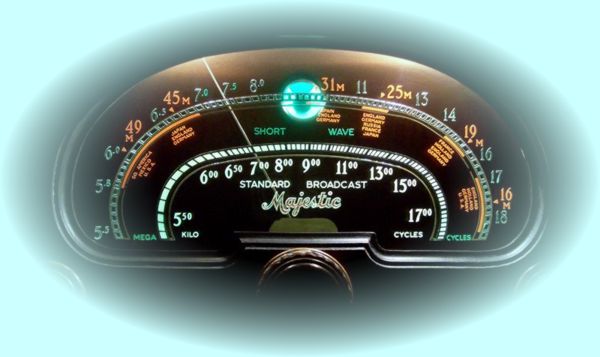Large and Beautiful Short-Wave Radio with Automatic Push-Button Tuning and Magic Eye Tuning Indicator made by Rogers Majestic in 1938
In a Nutshell
The reverse etched and painted glass dials of 1930's Rogers Majestic and DeForest-Crosley radios are unrivaled
 |
Introduction:
Here again we have a radio, that was made by three Canadian companies under different model numbers: Rogers "13-71", Majestic "871", and DeForest-Crosley "Elgar". All have a chassis 8X723, where X equals R for Rogers, M for Majestic, and D for DeForest-Crosley. The same chassis was also used in consoles by the same 3 companies, the 13-76, 876, and "Bizet", respectively. The metal type plate on the back of the chassis generally says: "Rogers Majestic Corporation Limited, Toronto, Canada" for both, R and M, with the addition "for DeForest Crosley Limited" for D, and has a background color of black, turquoise and red, respectively (before 1935 the plates seem to all have been black, see my other ad about a Rogers Majestic 7R621). Many of these 1930's radios have very beautiful multi-colored glass dials, where the glass is etched and painted from the back side. This paint is very often brittle and flakes off, but is easily reapplied thanks to the etched groves. The "Majestic" logo and the white Standard Broadcast scale of this dial could be easily restored
For the historians only:
Edward Samuel ("Ted") Rogers (1900-1939): kid telegrapher, invented the first A/C tube, in 1925 established "Canada's First Rogers Batteryless" (CFRB) both, as a radio factory and a broadcast station and in 1928 the Rogers-Majestic Corporation, in 1934 acquired Consolidated Industries, which built DeForest-Crosley Radios in Canada, in 1933 created the Spray-Shield Tube which eliminated the need for protective tube cans, and conducted the first public demonstration of television in Toronto, died much too early at age 38. His five years old son of same name was too young to follow his father's footsteps, perhaps to his advantage, since the future President and CEO of Rogers Communications Inc., who died two years ago on Dec. 2nd, 2008 at age 75, was the fifth richest person in Canada in terms of net worth. Father and son in 2006, were inducted into Canada's Telecommunications Hall of Fame.
Lee de Forest (1873-1961): "father of radio" and "grandfather of television", invented the Audion tube in 1906,
in 1934 established Lee de Forest, Inc., Los Angeles, Calif.,
supported for Nobel Prize for Physics, in 1959 received an honorary Oscar instead, owned 180 patents, but needed Edwin Armstrong to understand them, and David Sarnoff to commercialize them, married 4 times.
For the techies only:
The tubes used for both, Rogers Majestic and DeForest-Crosley radios, are special developments by Rogers, and have no counterparts from other manufacturers, and are therefore hard to replace. As rectifier mostly two (sometimes 4) 2X3 were used, the magic eye tube was a 6X6, and the other tubes were Rogers spray-shield tubes (see above, they have a "M" added to the tube number). Usually the two 2X3 are substituted by a 5Y3 and a dummy, the 6X6 magic eye (new about $125) by a 1629, and the spray shield tubes by their regular equivalent, if necessary supplemented by a metal shield. This radio still has its original 2X3 and one 6K7M tube. The radio uses a number of other special components, such as 2 Mallory bias cells (ref.2 below). This are small devices, which function like a low power battery, and supply negative bias to tube grids, without necessitating a separate power supply. These cells work with electrolytes and normally have been dried out. They can be rejuvenated (if still there) or substituted by a normal 1.5 Volt battery. This radio still has one original bias cell.
Additional information:
ref. 1. http://www.radiomuseum.org/r/rogerstube_majestic_871_ch_8m723.html
ref. 2 http://www.antiquewireless.org/otb/biascell.htm
About my radio:
The radio has been nicely refinished by a previous owner, except the top that still appears in its original shiny and very homogeneous black. The radio retains all four original wooden knobs. The reverse painted glass dial (see above) has been restored to mint condition. A new magic eye tube 1629 has been installed and tubes replaced as necessary (see techies above).
I treated all moving parts with contact spray, replaced one missing bias cell and replaced capacitors where necessary. The radio plays loud and clear on AM/BC and receives SW stations, the station preselect buttons work flawlessly, and the magic eye tube is bright green, as it should be. Please
e-mail me (Kris) for any questions, ich spreche Deutsch, je parle Français.
Here are the specifications:
| Technical Description of Item |
| Manufacturer |
Rogers Majestic Corp. Ltd., Toronto, Canada |
| Model |
8M723 |
| Type |
7-tube MW, SW Superheterodyne radio receiver with automatic tuning |
| Production Year |
1938 |
| Serial Number |
B 36306 |
| Cabinet |
3-tone wood |
| Dial |
Illuminated reverse etched and 5-color painted glass |
| Knobs |
4 original wooden knobs |
| Frequency Range |
MW/BC 520-1750 kHz, SW 5.5-18.5 MHz |
| Controls |
Volume, fine tuning, on/off - tone, band select, 6 preset station push-buttons |
| Tube line-up |
6J8M (6K8), 6K7M, 75M (6Q7), 41M (6F6), 6X6 (1629), 2X3, 2X3 |
| Size (WxDxH) |
20½" x 11" x 12" |
| Weight |
32 lbs = 14.7 kg |
| Comment |
An impressive radio in excellent and working condition |
|




